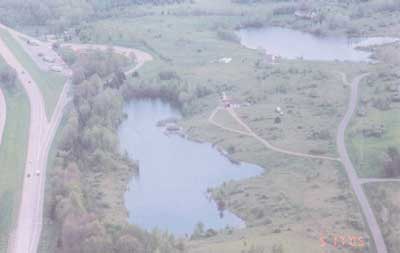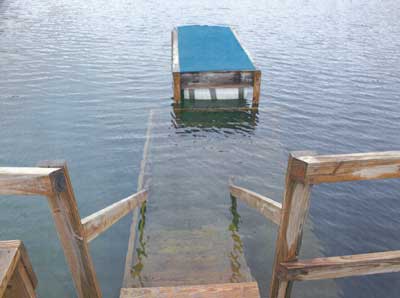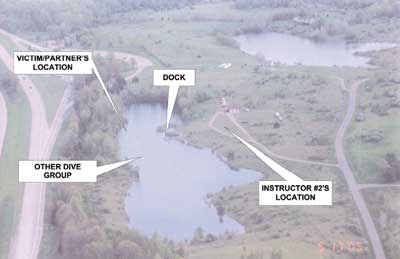

On August 28, 2005, a 50-year-old male volunteer fire fighter/rescue diver (the victim) died after nearly drowning during a fire department sponsored night-dive training exercise at a quarry the night before. The victim had performed a total of three training dives the day of the incident (August 27, 2005) as part of the requirements for Professional Association of Diving Instructors (PADI) certifications for advanced open water diver and night diver.
After the students completed the exercises for the “night dive,” they were instructed to complete the training dive with a “partner dive.” During the partner dive, the victim’s partner reportedly signaled to him that he wanted to surface, and the victim signaled back “OK, let’s surface.” After the partner surfaced, he looked around and did not see the victim. The partner reportedly looked down and saw the victim still below him waving his light from side to side in a distress motion. The partner dove back down and found that the victim did not have his regulator in his mouth.
The partner tried to donate his alternate air source, but at that point the victim’s underwater flashlight dropped and he went limp. The partner brought him to the surface and yelled for help. At this time the master scuba diver instructing the course (Instructor #1) and his partner were below the surface on the partner dive in another part of the quarry. Another dive instructor (Instructor #2) and a diver on shore unrelated to this training heard the calls for help and immediately went to provide assistance. The victim was towed to shore and provided cardio-pulmonary resuscitation (CPR). Emergency 911 was called and arrived within 15 minutes. The victim was transported to a local hospital where he died the following day.
NIOSH investigators concluded that, to minimize the risk of similar occurrences, fire/rescue departments should:
 |
Photo courtesy of the fire department. |
On August 28, 2005, a 50-year-old male volunteer fire fighter/rescue diver (the victim) died after nearly drowning during a fire department sponsored night-dive training exercise at a quarry the night before.
On August 29, 2005, the U.S. Fire Administration notified the National Institute for Occupational Safety and Health (NIOSH) of this incident. On October 14, 2005, the Chief of the Fatality Investigations Team and a Safety and Occupational Health Specialist from the NIOSH Fire Fighter Fatality Investigation and Prevention Program (FFFIPP) investigated this incident. Meetings were conducted with the Chief of dive operations, Instructor #1, and Instructor #1’s dive buddy on the night of the incident. The Chief of dive operations was not present at this training, but provided investigators with needed documentation and background information.
The investigators reviewed the victim’s training records, the department’s Self Contained Underwater Breathing Apparatus (SCUBA) team rescue operations SOPs, the certificates of air quality tests of air used in the victim’s SCUBA tank, the victim’s dive equipment, and the victim’s diver’s passport (note: for all intents and purposes, a diver’s passport is a personal record of dives completed). NIOSH investigators also reviewed copies of diagrams of the quarry where the incident occurred, photographs, and witness statements.
Department
The volunteer fire/rescue department involved in this incident has 4 stations, 80 uniformed fire fighters, and serves a population of approximately 12,000 in an area of about 9 square miles. One of the stations houses a paid ambulance service.
Dive Team
The incident department’s dive team was established in 1994 and has an 18-member roster. The dive team provides mutual aid dive services for the Northwest region of Pennsylvania. The team consists of 3 levels: 1) Entry Level; 2) Operations Level; and 3) Technical Level. Of the 18-member team, 6 members are considered to be trained to the technical level by the department, and are issued equipment for dive team response to emergency situations. The victim was considered to have reached the operations level, and was permitted by the department to participate in selected recovery or search incidents based on level of training and actual diving experience required by the department. The training courses being completed at the time of the incident were part of the training necessary to achieve the technical level designation by the department.
Victim’s Training and Experience
The victim had been diving for approximately 5 years, and had completed requirements for certifications in Basic Public Safety Diver, Equipment Specialist, and Dry Suit Diver. The victim participated with the department in 3 search dives for State, County, and local police departments from November of 2000 to July of 2003.
In addition to dive training and experience, the victim had completed a documented 64 hours of training related specifically to fire fighting since becoming a probationary fire fighter with this department 15 years earlier.
Equipment and Definitions
The victim was wearing/using the following equipment during the incident dive:
Air/Tank – The SCUBA tank contained compressed air, and was made of aluminum with a volume of 80ft3. The tank and related equipment were owned by the victim.
Dive Mask – A skirted glass window constructed to provide air space between eyes and water and to permit both eyes to see in the same plane.
Snorkel –A hollow tube swimmers or divers can breathe through when they are close to the surface.
Fins – A device that either slips on or straps to your feet to aid in propulsion while swimming.
Regulator – A device which changes air pressure from the air tank from a higher pressure to a lower pressure.
Submersible Pressure Gauge (SPG) – A device that allows the diver to continuously monitor the amount of air in the tank during a dive.
Depth Gauge – A device that indicates how far a diver is below the surface of the water.
Buoyancy Control Device (BCD) – An inflatable vest worn by the diver that can be automatically or orally inflated to help control buoyancy.
Alternate Air Source – A device a diver can use in place of the primary regulator, in order to make an ascent while still breathing normally.
Dry Suit – A water-tight garment that keeps the divers’ body warm by providing insulation with a layer of gas, such as air; for diving in waters that are too cold for comfortable wetsuit protection, usually below 65°F.
Primary and Secondary Light Source – Underwater flashlights
Personal Locator Beacon – Underwater strobe light used for personal location Incident
Site / Weather
The quarry where the incident took place had a maximum depth of approximately 45 feet. The water’s visibility was reported to be approximately 20 feet. The water temperature was recorded to be 75 degrees. The weather on the day of the incident was reported to be clear, with an air temperature of 85 degrees, and calm winds
The victim had performed a total of three dives on August 27, 2005. These dives were part of the requirements to gain an advanced open water and night diver PADI certification(s).
At approximately 1730 hours, the total of four divers involved in this training, including Instructor #1 (the course instructor) initiated a briefing for the dives, where it was identified that communication throughout the exercises would consist of verbal communication on the surface, and hand signals underwater.
The first of the three dives consisted of a daylight surface and underwater navigation dive. The dive consisted of an out and back pattern, a square pattern with a compass, and an out and back pattern without a compass. This dive took approximately 24 minutes to complete and reached a depth of approximately 20 feet. There were no problems reported, and after the daylight surface and underwater navigation dive the class took a break, changed air tanks, and reviewed the agenda for the upcoming portion of the night exercises.
At approximately 1900 hours, the crew of 4 completed a review of the second and third dive of the training - a “nighttime underwater navigation dive” and a “lights out dive.” At approximately 1930 hours, the four divers (including Instructor #1) initiated the nighttime underwater navigation dive, which was identical in practice to the daytime underwater portion of the dive completed earlier. The maximum depth of this dive was 21 feet. After the nighttime underwater navigation dive was complete, the victim changed air tanks again. Instructor #1 noted that the nighttime underwater navigation exercise was completed without incident and no problems were reported. After the navigation exercise was completed, Instructor #1 and the students began the third dive of the training – a “lights out dive.” The four divers entered the water and descended to a platform attached to the dock (Photo 1), turned off all light sources, and sat in darkness for just over four minutes at a depth of 20 feet. This dive was also completed without incident, and Instructor #1 reported that all three divers performed well.
At this point, with the exercises completed but prior to debriefing, Instructor #1 told the group to split up into pairs and begin a 20 minute “partner dive.” Instructor #1 and his partner progressed easterly, along the shore of the quarry. The victim and his partner followed them to a point and then broke off to investigate a submerged satellite dish. The depth at the area of the incident was approximately 12 feet. After completing their time underwater, the victim’s partner signaled to the victim that he was ready to surface. The victim reportedly signaled back "OK" and confirmed that they were going to surface. The victim’s partner began his ascent, and once on the surface, followed the PADI protocol of determining his location then checking to see if his partner surfaced successfully. The victim’s partner noted that he was straight out from the dock (Diagram 1), but could not locate his partner. The partner then placed his face back in the water to try to locate the victim, and he saw a flashlight go back and forth (distress signal). The partner then immediately descended back down to the victim, and noticed that the regulator was not in the victim’s mouth. The partner replaced the regulator and it fell from the victim’s mouth. The partner then took his alternate air source (an alternate, second stage air source used by a diver’s buddy to provide air to a partner in distress in an out-of-air situation) and placed it in the victim’s mouth, but it fell out as well. The partner immediately inflated the victim’s BCD and brought him to the surface. The partner then yelled for help to divers (Instructor #2 and a diver – both unrelated to this course) who by chance were in the area on shore. The estimated elapsed time at this point from the partner noticing the victim was in distress to yelling for help was less than one minute. Instructor #2 and the diver on shore immediately entered the water to provide assistance. After arriving at the location of the victim and his partner (Diagram 1), Instructor #2 and the assisting diver dumped the victim’s weights and assisted the partner in towing the victim to shore. At first, the victim appeared to be caught on something, so Instructor #2 told the victim’s partner to cut whatever was restricting their forward movement. The partner did so, and it turned out to be the victim’s alternate air source being caught in "seaweed" at the surface. The partner then reached over and turned off the air tank, as air was bleeding from the cut hose. The three divers (the partner, Instructor #2 and diver from shore) towed the victim to shore, and once on shore immediately initiated CPR. Emergency medical services were summoned and arrived within 15 minutes. Instructor #1 and his dive partner (a medical doctor) surfaced minutes later and assisted CPR. The victim was transported to a local hospital where he died the next day.
The coroner listed the cause of death as drowning.
Discussion: Operational protocols, minimum equipment, personnel requirements, qualifications for team membership, and issues of training, drills, health, and safety should all be addressed in fire department SCUBA team SOPs.1 Operational protocols should address specific needs such as a designated safety boat, backup divers, ninety-percent-ready diver, and emergency medical personnel to immediately respond to an emergency incident. SOPs should be reviewed in-house, at a minimum, on an annual basis to see whether any changes are necessary. Every team member should have a copy of the SOPs, and each member should sign a statement indicating that he/she has read, understands, and agrees to abide by them. While this department had operational SCUBA team operational protocols, there were no specific protocols (designated safety boat, backup divers, ninety-percent-ready diver) to be followed for or during dive training.
Discussion: Effective underwater communication refers to the capability to communicate between divers and from a diver to the surface. The divers present at this incident were able to communicate by using recognized dive signals such as a “thumbs-up” to indicate they were okay. Fire departments should follow OSHA safety standard 29 CFR 1910.424(c)(2) by ensuring that a diver be line-tended from the surface or accompanied by another diver in the water who is in continuous visual contact during the diving operations. The victim was a volunteer fire fighter and was not covered by OSHA regulations. However, following OSHA standards would provide additional protection for fire fighters who face unique environments and hazards associated with training or technical rescue operations.2 Effective communication and continuous visual contact are two ways in which divers can convey any equipment or medical problems they may be experiencing.3
Discussion: Public Safety Diving states that “in addition to having the normal duties of divers, a backup diver must be ready to act as a replacement if the primary is unable to perform for any reason, and he must be ready to render assistance if the primary diver runs into trouble. Because of the complex nature of diving, it’s always possible that the backup diver will experience a problem when called. Following a policy of having contingency plans in place, it’s best to have a second backup diver available, wearing an exposure suit and with his gear fully checked and functioning. If the backup diver is called on to make the descent, the ninety-percent-ready diver completes the dressing process so that he is fully ready to enter the water. With a ninety-percent-ready diver in place, the redundancy and safety of an operation increase dramatically.”1 In this incident, there were only the four divers present and participating in the training. No assigned backup diver or ninety-percent ready diver was present.
Effective underwater communication is imperative. Specifically, diver-to-diver and diver-to-surface communications should be established and maintained during the entire dive(s).3 Underwater electronic devices are available to establish diver-to-diver and diver-to-surface communications. In this incident, there were no personnel at the surface to perform monitoring, and underwater diver-to-diver electronic devices were not used. All communication was either through surface face-to-face verbal communications or underwater hand signals.
This investigation was conducted by Robert E. Koedam, Chief of the Fatality Investigations Team, and Jay Tarley, Safety and Occupational Health Specialist, Division of Safety Research / NIOSH.
 |
 |
Diagram 1. Location of personnel when incident occurred. |
Return to Fire Fighter Homepage
This page was last updated on 07/31/06.